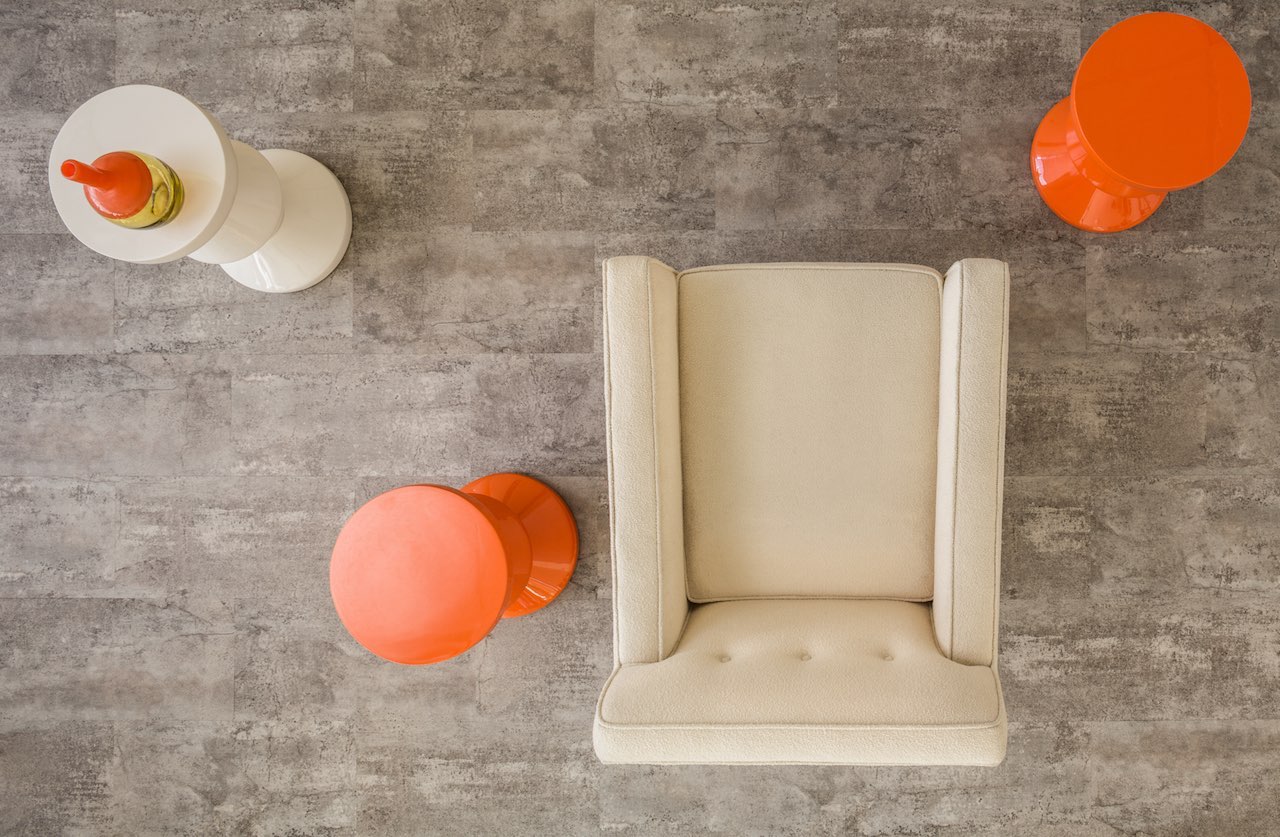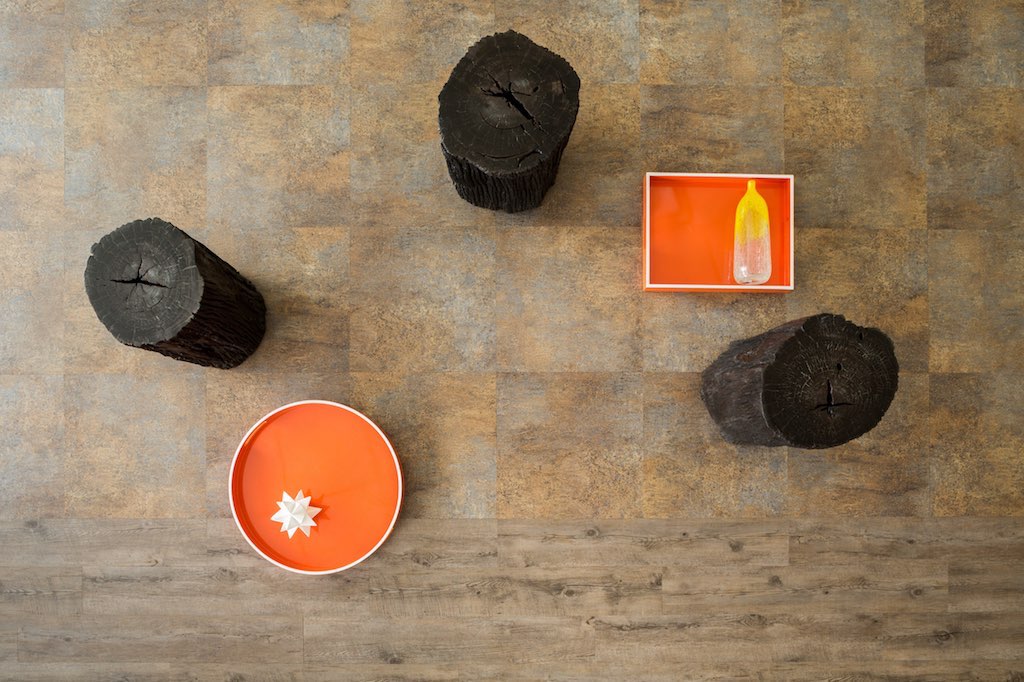Concrete vs. Luxury Vinyl Flooring

The look of concrete floors is a growing trend for both commercial and residential interior environments. Its popularity throughout the design community is not only due to the array of pattern and color choices concrete provides, but also for the sleek and clean aesthetic it creates within a space.
And while concrete flooring in and of itself is a solid flooring choice, interior designers have consistently relied upon luxury vinyl flooring to provide the popular concrete look. Not only is the installation of luxury vinyl flooring over concrete simple and seamless, the vinyl flooring itself is easier to maintain and offers a wider array of design choices that are sure to fit in with any interior design approach.
Needless to say, both concrete and luxury vinyl tile each have their own benefits. However, in order to truly understand the vinyl vs. concrete flooring comparison, it’s helpful to look at the following quantifiable qualities: Look & Style, Durability & Stability, Applications, Cost and Comfort.

Look & Style
When it come to design integrity, the vinyl vs. concrete comparison is where the two flooring solutions begin to separate themselves.
Concrete has become a popular material and design look for flooring and wall spaces throughout the retail and hospitality industries—often used in an attempt to add a more industrious look to a space. However, while the look of concrete is much sought after, the choices in style it provides may be limiting. Here’s why:
Concrete can be stained or dyed to match just about any color, and if desired, textural patterns can be applied to the concrete while it’s setting. With these techniques, you can achieve different stone-like looks, or polish the concrete for a smooth look. The different colors and textures created by concrete is even something that inspires luxury vinyl tile designs, however, with concrete, the design chosen is more permanent. Once a stain is applied, it’s permanent — so choosing the right look that is timeless is key.
In addition, when staining old concrete floors, the floor may not accept the stain due to previous sealants that have been applied or even current marks or stains may not allow for the new stain to absorb. To get the right staining effect, new concrete should be considered.
In several ways, luxury vinyl flooring is more flexible than concrete when it comes to design. Limitlessly customizable and designable, vinyl allows you the versatility you need to complete any interior design project. Vinyl can also replicate the look and style of natural materials—such as stained concrete or stone and wood designs.
Concrete Flooring
- Industrious/stylish look
- Numerous design options (polished/stained), yet permanent
- A current design trend in hospitality/retail, but not suitable for industries like healthcare
Vinyl Flooring
- Can replicate the look and style of concrete
- Limitlessly customizable and designable, suitable for most commercial industries
Durability & Stability
Before discussing the durability and stability of concrete flooring vs. vinyl, we should define the terms, as they seem similar:
- Durability: Hardness of the flooring—especially its topmost wear layer. The more durable a flooring solution is, the more use it can withstand.
- Stability: Governed by the thickness of the whole and/or makeup of layers and quality of materials. Stable flooring material holds its shape and size against moisture and/or climate changes.
This is where the concrete flooring vs. vinyl comparison gets more interesting. When it comes to durability, concrete lasts a very long time. In fact, concrete is likely the most durable and sustainable flooring product available today. But while it’s hard to beat in terms of its long-lasting qualities, its permanency causes some consternation among interior design professionals and their clients. For example, businesses in the retail and hospitality industry like to switch up the interior design of their spaces every few years as trends change.
In addition, selecting stained or polished concrete requires meticulous floor preparation. Stains and polishes are not made to disguise imperfections, so any debris that may be remaining will show through. For old concrete, any stains will not allow for the new stain to penetrate, preventing the stain from taking. In addition, to provide a protective layer for the surface, concrete will need to be sealed regularly, depending on the amount of traffic.
Luxury vinyl, however, is different for a couple of reasons—Parterre premium vinyl in particular. While both concrete and vinyl are similar in terms of cleaning requirements (a simple wet mop and cleaner), vinyl is made using a hard, closed-cell vinyl material that allows for the flooring to be more water resistant and ideal for higher-moisture areas when using the right adhesive. Concrete, if not sealed properly, is susceptible to moisture penetration. If moisture or liquid does make its way to the pores, it can sit within and lead to mold or mildew. Also, if the moisture freezes, it can lead to cracking.
Most luxury vinyl already has a wear layer with a polyurethane top coat for easier maintenance and resistance to staining and scuffing.
Concrete Flooring
- Long-lasting
- Requires careful, extensive prep work
- Susceptible to sealant wear in high traffic areas
Vinyl Flooring
- More water resistant and ideal for higher-moisture areas
- Does not require a sealant
Cost
There are multiple factors that go into the cost structure of concrete, but for the most basic concrete look, it is comparable to vinyl. More elaborate looks, or to completely refinish the floor, may incur more labor costs and down time.
- Concrete — Depending on the look and complexity, concrete can cost between $2 to $6 per square foot and up to $15 to $30 per square foot for more elaborate finishes. This pricing is also dependent on whether a concrete slab currently exists and the amount of preparation is needed to apply stain or polish to the concrete.
- Luxury vinyl — Vinyl can cost anywhere from $2—$5 per square foot for commercial-grade material, not including installation.
At the end of the day, luxury vinyl wins out when factoring in the flexibility it allows in terms of design and application. While comparable to concrete in terms of cost, vinyl offers greater long-term value—especially in terms of comfort.
Concrete Flooring
- In addition to having to lay the concrete, pricing considerations should factor in the cost of prep work, staining and/or polishing cost of materials and labor
Vinyl Flooring
- Vinyl can often be priced similarly to concrete, but offers a much higher value when looking for more elaborate concrete finishes
Comfort
Comfort is also a major component of the concrete vs vinyl comparison. For example, a national clothing retailer used concrete in all of its stores only to find out that their employees were having to change their shoes throughout the day due to the pain of walking and standing on such a hard surface. It can also be a liability for several interior settings.
While a sturdy material, concrete flooring features a certain amount of hardness that can be challenging in various applications. Concrete is also not ideal in terms of noise—as it can often lead to overblown acoustics, especially within an open area. It’s not surprising that many businesses that originally choose concrete for their space(s) end up switching to vinyl flooring for its versatile design qualities, not to mention added comfort level.
Concrete Flooring
- While rugged and sturdy, concrete’s hardness can be uncomfortable at times
Vinyl Flooring
- Vinyl offers added comfort, especially with additional underlayment
Applications
As mentioned earlier, the application of concrete is limited to only a few industries—hospitality, retail, supermarket and corporate office space being the most notable. While there’s no doubt that the concrete flooring trend will continue, designers can rest assured knowing they can easily recreate their space by adding luxury vinyl into the mix.
Because of its multi-faceted, cross-purpose functionality, luxury vinyl flooring makes a suitable flooring solution for almost any environment—no matter if it’s healthcare, education, multi-family, corporate, supermarket retail, or hospitality. Vinyl performs particularly well in areas susceptible to high moisture and humidity.
Concrete Flooring
- Limited to certain applications due to its hard nature
Vinyl Flooring
- Multi-faceted, cross-purpose functionality
Look & Style
Cost
Durability & Stability
Applications
If you found this comparison of luxury vinyl vs. concrete flooring helpful, you can find more information on our blog, including this post—“Why is Vinyl Flooring The Fastest Growing Material?” Feel free to contact us to find out more about why Parterre has become the leader in modern, high-quality premium vinyl flooring. We would love to work with you on your next project.
Parterre Flooring
Read MorePolished Concrete vs. Vinyl Flooring
Polished Concrete vs. Vinyl Flooring Polished concrete vs. vinyl flooring. It’s not an easy decision, considering both provide an excellent solution for commercial flooring. The look of concrete floors has been a growing trend for commercial interiors.
Chevron and Herringbone
Break the Pattern of Commercial Flooring You can add more flair to your commercial flooring by breaking from the look of traditional straight-line, square, and diagonal patterns. Eye-catching looks like chevron and herringbone will dot the designer landscape in 2024.